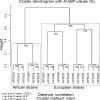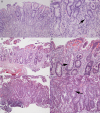Phylogeographic origin of Helicobacter pylori determines host-adaptive responses upon coculture with gastric epithelial cells
- PMID: 23630959
- PMCID: PMC3697613
- DOI: 10.1128/IAI.01182-12
Phylogeographic origin of Helicobacter pylori determines host-adaptive responses upon coculture with gastric epithelial cells
Abstract
While Helicobacter pylori infects over 50% of the world's population, the mechanisms involved in the development of gastric disease are not fully understood. Bacterial, host, and environmental factors play a role in disease outcome. To investigate the role of bacterial factors in H. pylori pathogenesis, global gene expression of six H. pylori isolates was analyzed during coculture with gastric epithelial cells. Clustering analysis of six Colombian clinical isolates from a region with low gastric cancer risk and a region with high gastric cancer risk segregated strains based on their phylogeographic origin. One hundred forty-six genes had increased expression in European strains, while 350 genes had increased expression in African strains. Differential expression was observed in genes associated with motility, pathogenicity, and other adaptations to the host environment. European strains had greater expression of the virulence factors cagA, vacA, and babB and were associated with increased gastric histologic lesions in patients. In AGS cells, European strains promoted significantly higher interleukin-8 (IL-8) expression than did African strains. African strains significantly induced apoptosis, whereas only one European strain significantly induced apoptosis. Our data suggest that gene expression profiles of clinical isolates can discriminate strains by phylogeographic origin and that these profiles are associated with changes in expression of the proinflammatory and protumorigenic cytokine IL-8 and levels of apoptosis in host epithelial cells. These findings support the hypothesis that bacterial factors determined by the phylogeographic origin of H. pylori strains may promote increased gastric disease.
Figures




Similar articles
-
Virulence factors of Helicobacter pylori in Korean isolates do not influence proinflammatory cytokine gene expression and apoptosis in human gastric epithelial cells, nor do these factors influence the clinical outcome.J Gastroenterol. 2000 Dec;35(12):898-906. doi: 10.1007/s005350070003. J Gastroenterol. 2000. PMID: 11573725
-
Analysis of cagA in Helicobacter pylori strains from Colombian populations with contrasting gastric cancer risk reveals a biomarker for disease severity.Cancer Epidemiol Biomarkers Prev. 2011 Oct;20(10):2237-49. doi: 10.1158/1055-9965.EPI-11-0548. Epub 2011 Aug 22. Cancer Epidemiol Biomarkers Prev. 2011. PMID: 21859954 Free PMC article.
-
Heterogeneity in the activity of Mexican Helicobacter pylori strains in gastric epithelial cells and its association with diversity in the cagA gene.Infect Immun. 2007 Jul;75(7):3445-54. doi: 10.1128/IAI.01951-06. Epub 2007 Apr 16. Infect Immun. 2007. PMID: 17438024 Free PMC article.
-
Influence of Helicobacter pylori virulence factors CagA and VacA on pathogenesis of gastrointestinal disorders.Microb Pathog. 2018 Apr;117:43-48. doi: 10.1016/j.micpath.2018.02.016. Epub 2018 Feb 9. Microb Pathog. 2018. PMID: 29432909 Review.
-
Assessment of the mixed origin of the gastric epithelial extracellular vesicles in acellular transfer of Helicobacter pylori toxins and a systematic review.Microb Pathog. 2023 Apr;177:106024. doi: 10.1016/j.micpath.2023.106024. Epub 2023 Feb 8. Microb Pathog. 2023. PMID: 36758823
Cited by
-
Helicobacter pylori-related risk predictors of gastric cancer: The latest models, challenges, and future prospects.Cancer Med. 2020 Jul;9(13):4808-4822. doi: 10.1002/cam4.3068. Epub 2020 May 4. Cancer Med. 2020. PMID: 32363738 Free PMC article. Review.
-
Helicobacter pylori infection: An overview of bacterial virulence factors and pathogenesis.Biomed J. 2016 Feb;39(1):14-23. doi: 10.1016/j.bj.2015.06.002. Epub 2016 Apr 1. Biomed J. 2016. PMID: 27105595 Free PMC article. Review.
-
Shedding Light on the African Enigma: In Vitro Testing of Homo sapiens-Helicobacter pylori Coevolution.Microorganisms. 2021 Jan 25;9(2):240. doi: 10.3390/microorganisms9020240. Microorganisms. 2021. PMID: 33503840 Free PMC article.
-
Human and Helicobacter pylori Interactions Determine the Outcome of Gastric Diseases.Curr Top Microbiol Immunol. 2017;400:27-52. doi: 10.1007/978-3-319-50520-6_2. Curr Top Microbiol Immunol. 2017. PMID: 28124148 Free PMC article. Review.
-
Interleukin-8 does not influence proliferation of the SGC7901 gastric cancer cell line.Oncol Lett. 2014 Dec;8(6):2475-2480. doi: 10.3892/ol.2014.2531. Epub 2014 Sep 12. Oncol Lett. 2014. PMID: 25364410 Free PMC article.
References
Publication types
MeSH terms
Substances
Grants and funding
- P01CA116087/CA/NCI NIH HHS/United States
- P01CA026731/CA/NCI NIH HHS/United States
- R01 AT004821/AT/NCCIH NIH HHS/United States
- P30 ES002109/ES/NIEHS NIH HHS/United States
- P01 CA116087/CA/NCI NIH HHS/United States
- P01 CA026731/CA/NCI NIH HHS/United States
- P30DK058404/DK/NIDDK NIH HHS/United States
- UL1 RR024975/RR/NCRR NIH HHS/United States
- R01DK053620/DK/NIDDK NIH HHS/United States
- P01CA028842/CA/NCI NIH HHS/United States
- R01 DK053620/DK/NIDDK NIH HHS/United States
- P01 CA028842/CA/NCI NIH HHS/United States
- P30 DK058404/DK/NIDDK NIH HHS/United States
- P30ES002109/ES/NIEHS NIH HHS/United States
- UL1RR024975/RR/NCRR NIH HHS/United States
- I01 BX001453/BX/BLRD VA/United States
LinkOut - more resources
Full Text Sources
Other Literature Sources
Molecular Biology Databases

